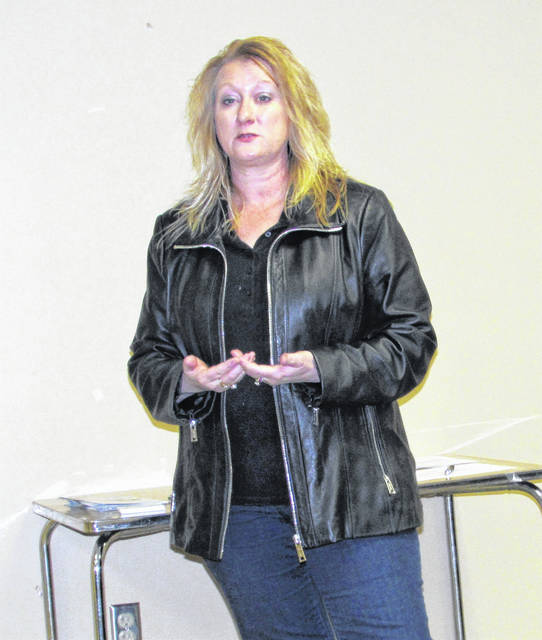
Saying that the escalating worldwide problem of human trafficking is driven by money, REACH for Tomorrow Director of Advocacy Beth Bullock described her presentation to the Highland County Drug Abuse Coalition Thursday as “Human Trafficking 101.”
She said that although the problem has been around for years, the current opioid epidemic has transformed human trafficking into a high dollar industry with tentacles that reach all the way into Highland County.
“There are over 40 million people around the globe that are victims of human trafficking,” she said. “When you break that number down, there are about 200,000 in the United States and about 17,500 coming across our borders every year.”
Bullock’s present role with the organization is working with a local grant to bring awareness and education to Ohio and different organizations regarding human trafficking. She said there is a tremendous amount of money being made at the expense of the innocent and vulnerable.
To illustrate how profitable it is for perpetrators to “groom” potential targets, Bullock shared potentially how much money just one victim can generate.
“They all have a daily quota, which on average is about $1,000,” she said. “They literally keep them under their thumb six days a week, 52 weeks a year — that’s over $300,000 for just one human trafficking victim.”
She defined human trafficking as the exploitation of an individual solely for the financial gain of another, and said it takes many forms.
“There’s the obvious commercial sex trafficking where people are being bought and sold for sex, which is about 25 percent of the trafficking nationwide,” Bullock said. “But there’s also labor trafficking where someone is held in debt bondage or involuntary servitude, where people aren’t allowed to leave, have to stay in one location and don’t have control of their lives.”
She said the problem is usually “hiding in plain sight” and from a local standpoint, people have probably witnessed it first-hand on a regular basis and did not realize it.
Some of the red-flags of human trafficking, Bullock said, are a lack of eye contact from the victim combined with a high level of anxiety on their part, as if they’re afraid they might say something that will cause punishment like a beating from the trafficker later on.
Another clue that something isn’t right, she said, is when another person does all the talking for them, even in a medical situation like a visit to the doctor, or that they can’t produce any form of identification when asked.
“In teenagers, be aware of drastic mood changes, signs of depression and having nightmares,” she said. “When you notice they’re out at all hours of the night and then won’t tell you where they’ve been, that their grades are dropping or that they now have a ‘friend’ who is older than them, say in their late 20s, and keep in mind it isn’t always men since women can be ‘recruiters,’ too.”
Another misconception relating to human trafficking is that recruiters are always older and groom younger victims, which isn’t always the case.
In her presentation, Bullock described a situation where an elderly man was with a younger person and elder abuse entered the equation.
“We know that we have elder abuse going on and there are people who take advantage of our elderly,” she said. “It may start innocently as somebody needing help, and then because of the prescriptions and the money like Social Security and pensions, this person who comes in to help, who could also be a family member, sees this elderly person as a revenue stream to support a drug habit and through threats of violence, begins to control them.”
She said that Ohio has become one of the hotbeds of human trafficking in recent years, not because of drugs or poverty, but because of its intricate network of highways.
“We have U.S. 23 that comes in from West Virginia and goes through Columbus and Toledo and into Detroit,” she said. “There’s I-275 which will take you into three states in about half an hour, and I-71 and I-75 provide north/south interstate access and I-74 takes you into Chicago and a lot of our drug trafficking comes from there.”
Bullock said there needs to be a concerted effort at educating everyone in the community so that they will be aware of the problem, and that there should be someone in each community to spearhead the education and training concerning human trafficking.
“It’s a very low-risk, high profit industry because there has to be a lot of evidence to convict a trafficker,” Bullock said, “and when you look at these poor victims who are threatened and intimidated, who’s going to tell?”
Reach Tim Colliver at 937-402-2571.


